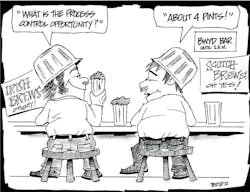Greg: Monsanto started a process control improvement (PCI) program in the early 1990s. A PCI group was funded up-front to find opportunities and implement solutions. Plants did not have to pay for services of the team, but did need to commit to do an opportunity assessment and provide resources based on the benefits found. To benchmark what had been done in the chemical industry, the team visited 12 companies that were considered to be the best in process control. The results were reported to the Chemical Manufacturing Association's (CMA) Process Control Task Group in my June 30, 1993, report, "Opportunities in Process Control."
Stan: The key person in the PCI group who led most of the opportunity assessments was Glenn Mertz, who spent his career in a plant and had skills and a keen interest not only in process control, but also in working with financials. The rest of the PCI group members were modeling and control specialists recovered from what was a world-class engineering technology (ET) department that was doing a disappearing act (another story).
Greg: I visited both Stan and Glenn on my recent vacation in southwest Florida. In talking with them, the importance of the human factor became evident.
Even the best ideas may never see the light of day. Glenn had an advantage going into a plant because he was perceived as a plant person. However well-respected internationally, the corporate PCI specialists were viewed as outsiders. Tribal instincts and egos can get the best of people, particularly those without a technical understanding. The great thing about process and control engineers at the working level is that for them evidence rules. Automation systems are windows into and handles for the process and, thus, the source of evidence.
Stan: What was the biggest problem you faced going into a plant?
Glenn: The statements up-front, "Everything is perfect," or from the less idealistic, "It is as good as it is going to get," were discouraging. The problem was particularly endemic with upper level managers, who wanted to prevent interference with their decision-making process and were more interested in not making past decisions look bad versus making new decisions to look better.
Stan: What type of champion were you looking for at the plant?
Glenn: We succeeded the most when our key interface had technical understanding, was open to new ideas, looked for the positives rather than negatives, was patient in working through problems, and had a great personal relationship with the operators. I started each day onsite in the control room talking to the operators.
Greg: What other people needed to be involved in the PCI implementation?
Glenn: Absolutely critical was the involvement of the process engineer supporting the production unit and the control engineer responsible for the distributed control system (DCS) configuration. The analyzer specialist and E&I engineers were only needed on an occasional basis since we were doing mostly "quick hits" that simply involved configuration changes.
Stan: What were the most exciting opportunities?
Glenn: We would start drooling when an increase in feed rate was needed. This was the easiest nut to crack and quick to implement.
Greg: The PCI process is outlined in my note pages. "Opportunity Sizing and Assessment." The result of the opportunity-sizing was a gap from the actual versus a target production rate, yield or quality improvement. Simulations were used to establish theoretical targets, but the more convincing target was the practical target found by Glenn by going through the cost sheets. How did you manage to gain access and analyze the cost sheets?
Glenn: Outsiders do not get to see the cost sheets, but from being from a plant and managing my real estate businesses, including doing all the numbers, I could talk my way into seeing and analyzing the financials. I took the best with a grain of salt. The week or month of exceptional performance could be an outlier for any number of reasons.
Greg: It was amazing to me how some plants with many forms of product and many customers had no on-line production rate measurement. Large continuous intermediates plants had recycle stream effects that would build over a course of weeks, confusing process and research for decades. The foremost industry expert in advance process control concluded that model predictive control was a waste of time until a real-time optimization could figure out what is really going on because of the non-self-regulation from recycle.
Stan: How did you come up with the actual target?
Glenn: Finding the best month was a bit of an art. Any result was thoroughly discussed with the process engineer supporting the unit and the operations supervision. We then went into a two-day opportunity assessment (OA) meeting with agreed upon gaps and evidence.
Greg: What was the key to a successful OA meeting?
Glenn: It was critical to not just start offering solutions and not jump to conclusions. Nothing turns off a plant more than an outsider, whether from corporate or from a supplier, presenting a solution before giving the plant an extensive opportunity to fully explain what is happening. The best thing specialists can do for the first half-day is to keep their mouths shut except to ask questions.
Stan: How did you get the plant to open up?
Glenn: We had the process engineer go over the control diagrams, which were between a process flow diagram (PFD) with a skeleton of control schemes, and the piping and instrument diagrams (P&IDs) that had way too much detail. The process engineer often prepared a sketch, since control diagrams are not an official required document. Operations chipped in, and had a chance to talk about what actually happens in the control room. Pointed questions were normally needed to get the right thought process going. It was harder to get at lab-sample and analysis issues since most lab systems were not integrated into the data historian. We looked at on-line trends of process measurements and flows over intelligent time horizons. There was never enough ability to show all the related variables on the same trend or find the right period of operation since there was no automation of cost-sheet-to-trend setup.
Greg: How did you get agreement?
Glenn: I led the discussion where the specialists started to offer ideas. I always looked to the process engineer to qualify or reject the idea. For accepted solutions, a time and resource requirement was estimated by the plant process control engineer, and a ball park percentage of the gap addressed was offered by the process engineer. The results were prioritized based on speed, investment and value. The low hanging fruit were often harvested in the next few days. Longer term effort required follow-up visits and often a revitalization of interest and knowledge.
Stan: What happened to the program?
Glenn: After achieving on the average a 4% reduction in the cost of goods, enthusiasm waned possibly due to a view of the chemical business as a cash cow and the need to save some benefits to justify the migration to the next generation of DCS.
Paul's Top Thirty Signs of an Opportunity Assessment that Has Gone Too Long and Wrong
30. Your laptop computer dies and becomes obsolete.
29. Area operators volunteer to manually shovel out the dryer in a pouring rain and other horrible duties rather than go one-on-one with the OA team.
28. The plant manager threatens to send you to diversity training if you use one more four-letter word.
27. You start to fantasize about diversity training instead of spending one more minute in the OA.
26. The plant personnel start referring to the OA team as Moe, Larry and Curley.
25. To avoid sitting through two more hours, the meeting leader volunteers to fly home to snow and rain to chauffeur the kids on Halloween.
24. You start to prefer the smell of chemicals to the smell of the person next to you.
23. You start to name pieces of equipment after team members like "Randy the Reboiler."
22. The operators start showing you photographs of their favorite guns, cousins and livestock.
21. People in the plant characterize the OA team as "Men Behaving Badly."
20. You start to sound like a used car salesperson when trying to describe the benefits of advanced control.
19. You ditch the meeting to attend an all day-telecom with your boss Bob to become Bob's best butt boy.
18. You begin each session with a heated argument whether the "No Donuts at Company Meetings" is real or a fake memo in the rumors database.
17. When the water balance is mentioned, you immediately get up and go to the rest room.
16. When someone mentions decoupling the inventory control from the concentration control, you start estimating the effect of the 10 Dr. Peppers you had.
15. You find that the "sweet spot" has nothing to do with the process, but is the name of the chair in the control room without a spring sticking up in the seat.
14. There are more OA participants in the restroom than in the meeting.
13. The solution to every control opportunity is a neural network, expert system or older-than-dirt FORTRAN.
12. You choose the "hot dog special" so the indigestion will keep you awake the rest of the afternoon.
11. Lunch break becomes known as the "Exodus."
10. You refer to the guy belching on the "hot dog special" as "El Niño.
9. The servers in the cafeteria chow line start looking good to you.
8. You have a recurring nightmare in which you build a neural network to inferentially measure an impurity that is only correlated with your company's stock price.
7. The pressure and stress of the OA makes you actually consider giving your spouse 55 "You Are Entitled to Be Crabby All Day" coupons.
6. You sadistically harass the guy next to you by noisily eating an apple when you know he forgot his banana.
5. You spend two hours deciding whether to install a $2K analyzer or if a five-year effort to build a neural network to infer moisture should go into phase II.
4. You use the term "redneck" to describe the person you told that their implementation technology is ancient history and belongs in a museum.
3. You start calling the supervisory control system "Mir."
2. You spend two weeks working on the OA summary before you realize the process improvements are the same as the ones from the OA you did five years ago.
1. The corporate guys get up and leave you behind to defend a briefcase full of "nebulous crap."
About the Author
Stan Weiner*
Contributor
Greg McMillan
Columnist
Greg K. McMillan captures the wisdom of talented leaders in process control and adds his perspective based on more than 50 years of experience, cartoons by Ted Williams and Top 10 lists.

Leaders relevant to this article:



